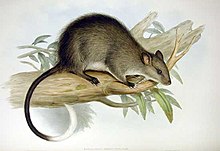Black-footed tree-rat
| Black-footed tree-rat | |
|---|---|

| |
| Scientific classification | |
| Domain: | Eukaryota |
| Kingdom: | Animalia |
| Phylum: | Chordata |
| Class: | Mammalia |
| Order: | Rodentia |
| Family: | Muridae |
| Genus: | Mesembriomys |
| Species: | M. gouldii
|
| Binomial name | |
| Mesembriomys gouldii (Gray, 1843)[1]
| |
| Synonyms | |
|
Hapalotis hirsutus Gould, 1842 | |
The black-footed tree-rat also known as Djintamoonga[2] (Mesembriomys gouldii) is one of two endemic arboreal rat species from the genus Mesembriomys found in the northern regions of Australia.
The species is one of the largest murids found in Australia.[3]
Description
The tree rat has a greyish-brown coat that is shaggy and coarse and has a creamy white underbelly. The hind feet are black with well developed pads and strong sharp claws. They have large ears and a long tail with a brush of white hair at the tip.[3] They grow to a mass of 830 grams (29 oz).[4] The height of the rat is typically 250 to 310 millimetres (9.8 to 12.2 in) with a length of 320 to 420 millimetres (13 to 17 in).[5]
Behaviour
The tree rat is solitary and nocturnal, it is arboreal sheltering in tree hollows and pandanus stands during the day.[4][5]
Feeding
It is a folivore and frugivore and its diet may be supplemented by invertebrates such as termites and molluscs.
Distribution
Mesembriomys gouldii has a range extending from the savannahs of Cape York Peninsula in Queensland westward to the Kimberley region of Western Australia.[5] Habitats such as tropical woodlands or open forest are suitable for the tree rat.[4] It is not commonly found across the area and the population has been reduced between 30 and 50% in the last decade.[5] The estimated population is 30,000.[5]
References
Footnotes
- ^ a b Woinarski, J.; Burbidge, A.A. (2016). "Mesembriomys gouldii". IUCN Red List of Threatened Species. 2016: e.T13211A22448856. doi:10.2305/IUCN.UK.2016-2.RLTS.T13211A22448856.en.
{{cite journal}}: Unknown parameter|last-author-amp=ignored (|name-list-style=suggested) (help) - ^ "Mesembriomys gouldii gouldii — Black-footed Tree-rat (Kimberley and mainland Northern Territory), Djintamoonga". Biodiversity - Species Profile and Threats Database. Department of the Environment. 2016. Retrieved 1 January 2016.
- ^ a b "Black-footed tree-rats" (PDF). Northern Territory Government. July 2014. Archived from the original (PDF) on 7 March 2016. Retrieved 1 January 2016.
- ^ a b c Brydie Hill (2012). "Threatened Species of the Northern Territory - Mesembriomys gouldii" (PDF). Northern Territory Government. Archived from the original (PDF) on 16 March 2016. Retrieved 1 January 2015.
- ^ a b c d e "Black-footed Tree-rat". Australian Wildlife Conservancy. 2015. Retrieved 1 January 2016.
Bibliography
- Topi Pigula http://zoommagazin.iprima.cz/priroda/vedci-jasaji-nad-obri-krysou-ma-cerne-tlapky-zije-na-stromech http://zoommagazin.iprima.cz/ Czech TV Prima ZOOM - article about endangered rat]
- Musser, G. G. and M. D. Carleton. 2005. Superfamily Muroidea. pp. 894–1531 in Mammal Species of the World a Taxonomic and Geographic Reference. D. E. Wilson and D. M. Reeder eds. Johns Hopkins University Press, Baltimore.

